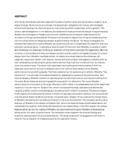| dc.description.abstract | Oral literary scholarship has often assumed the place of performance and has tended to evade it as an object of study. Performance as a concept has always been relegated to be merely acknowledged without delving deep into discovering its intrinsic meaning which is essentially culture-specific. This cursory acknowledgement in the absence of a substantive study portends the danger of superimposing Western terminologies on indigenous oral forms, stultifying the conceptual reasons behind the formation of the genres themselves
This study is an attempt to depart from these certitudes and enter into the critical tenets of
indigenous people as epitomized by the Boran. The study investigates the characteristic
features of a genre Weedhu as a performed art form
It postulates the argument that as a culturally conceived genre, it operates at several levels.
At the overt level Weedhu is a praise to cattle. Man endeavours to celebrate his life by an
exaltation of that which enhanced the happiness it.
But this is merely on the surface and there are deeper structure which underlie the facade of praise. At a much deeper level then, Weedhu manifests certain intricately connected features like challenge, call-response, reward and rebuke, role- playing, contest and confrontation and appeal to empathy with all their ambivalence constituting the performative element that mark the movement from an ordinary event into performance.
The action that is prevalent during the performance endows it with the theatrical touch and
the context of situation within the rubric of Jilla transforms the Weedhu performance into
something special. The final evaluation by the audience as to whether Weedhu "has become hot" is a culturally formulated yardstick for assessing the success of the performance.
As a cultural category, Weedhu is shown to express certain fundamental themes, deriving its meaning from the wider Boran discourse and servlng specific purposes for its adherents. The overal Weedhu performance is a microcosm of the larger jilla
event within which it is encapsulated and which essentially imparts to it its own imprint.
Chapter One, which introduces this study, stipulates and defines the research problem and the methodological orientations within which it is couched. The second chapter briefly explores the sociocultural context in which the operates and attains meaning. The various social matrices which shape the Boran worldview is touched upon.
Chapter Three explores the textual frame of Weedhu delineating the key features inherent in the texts and contexts.
The emergent performative features, of Weedhu is the subject of Chapter Four where the essential features delineated above are crystallized into a pattern with discernible structural interrelationships.
In the fifth chapter the various features which go into the making of Weedhu are examined and the genre Weedhu is illustrated as falling within the
realm of performance.
The conclusion draws together the diverse findings and problems, stating clearly the overal achievement.
The study closes with the suggestion that there is need for future research on indigenous genres through performance. | en |

